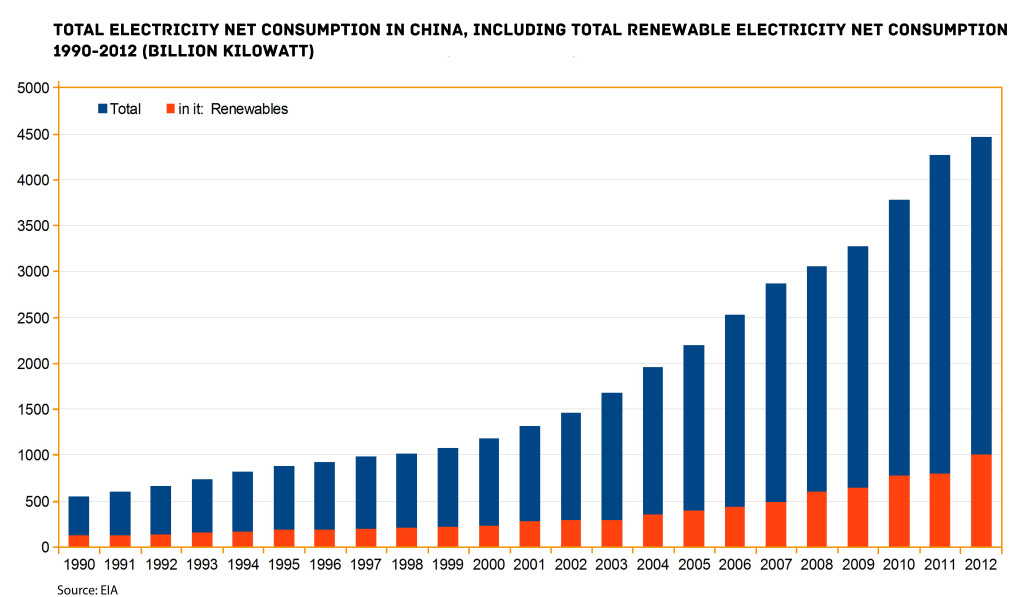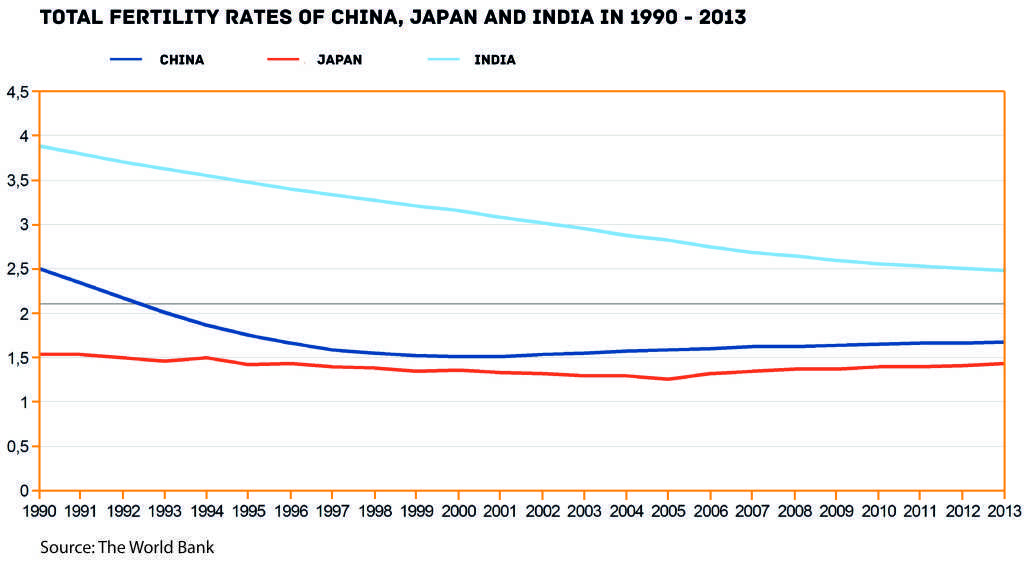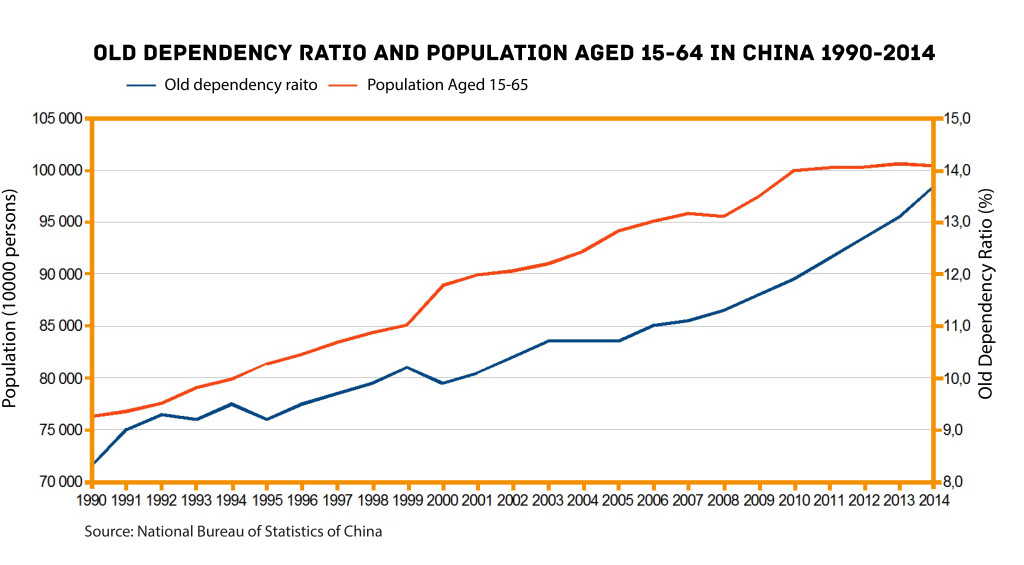Five years from now, China will be a different country. An ambitious transition plan from a developing economy to a highly developed economy, with a vibrant and wealthy society, was already initiated several years ago. The culmination of its implementation is going to be the years 2016-2020, the tool to achieve the goal will be the 13th Five-Year Plan, which designates the key objectives of socio-economic policy.
Among the priorities of a new Five-Year Plan (FYP) will be a drastic change in environmental policy, as well as further liberalization of the population policy. The main goal of the Communist Party of China (CPC) is to enhance quality of life of China’s inhabitants. Chinese Prime Minister Li Keqiang has already confirmed that the priority of the 13th FYP would be continued economic development, with emphasis on reformation and innovation1. This probably means, in line with the the goals of the Communist Party of China (CPC) announced in 2012, a growing domestic consumption, the modernization of the agricultural sector, reforming state-owned enterprises, a further development of the service sector, promoting strategic and emerging industries2, upgrading industrial infrastructure and reforming the energy pricing structure1. Fighting corruption is on the agenda as well.
There are two social issues that will be at least as important as the economic part of the 13th FYP:
- Demography and population policy,
- Environmental protection and its consequences for the economy.
According to the National People’s Congress Standing Committee, the current leadership, special attention will be paid to to healthcare, education, social security3 and income inequalities. It is still an open question how China will implement the plans and if in the end the result will correspond to the intentions. Our team doubts whether the CPC is able to make the Chinese dream come true, but ignoring the change in Chinese policy would be a grave error.
An aging population is a limitation for consumption growth
The demographic situation is not dramatic yet, but without radical measures China could repeat the Japan scenario. According to a UN study, India will overtake China as the most populated country of the world by 2022, with the Chinese population reaching its peak in 20254 according to the same estimation. It is still not too late to change the course because the sharp decline in population is predicted around 20505 while the demography structure of China is still far better now than that of Germany or Italy (see Populationpyramid.net).
Changes in the demographic trends are very slow, though. It is difficult to transform social customs, as for many years the one child policy was an issue of patriotism. According to the data of the National Health and Family Planning Commission, the number of applications for a second child was far below official projections6 since China liberalized its one child policy. The effects of population policy reforms do not fulfill expectations.
The coming FYP will probably further liberalize the one-child policy, but the Chinese policy makers know that it is not enough. They want to combine this policy with other kinds of social policy. However, planned pension reform, senior care policies and social welfare changes7 can induce the reverse effect, like in Europe, by declining the desire to have children as a retirement investment. Growing prosperity also contributes to reduced fertility.
The CPC plans for the Chinese dream could be hindered by a declining labor force (see chart 2). The increasing burden of old people (aging population) can be a significant obstacle to a radical consumption growth, designed by the authorities. It will also be a burden for the planned pension system.
Environmental protection as a bitter pill
Demography is a main cause for concern for Chinese rulers, but one of the greatest concerns of the Chinese society is pollution. Therefore energy efficiency and environmental protection (with more „forceful” measures8) should be one of the key points of the 13th FYP2.
It will likely include a total cap on carbon emissions8 and trading carbon scheme9. The Chinese may impose environmental taxes or more pollution control in order to reduce carbon dioxide emissions per unit of GDP in 2020 as compared to levels of 20059.
The government also wants to strengthen the renewable energy sector to raise the energy consumption from non-fossil fuels by 2025 to 20 percent of the total energy consumption8.

Efforts to improve the environment will obviously not only impact society, but also Chinese businesses. The people will not feel changes immediately, while highly polluting firms will be affected. The steel industry, petrochemical industry and energy sector, particularly coal power plants10 will take a financial hit. China will also try to reduce its carbon emission. The Carbon Credit Trade widely lobbied by the Banks could become a serious business as China is starting to launch a national cap-and-trade plan in 2017.
Opportunities
Despite many challenges, China is facing a number of opportunities, related to population and environmental policies. Consumption growth will occur even if demography problems are not fully resolved.
The continuously expanding middle-class will mimic European and US consumers. Chinese consumers will not only travel to Europe and the US but they will also look for relative cheap destinations closer to home. South-East Asia could see an increase in low cost mass tourism. Besides the tourist sector, automotive (electric cars!) and food industries will profit from the changes. The Chinese will spend their money on holidays, transport, better nourishment, electronic equipment; anything the consumers in the West are spending their money on. The Chinese are in a phase of changing from ‘modest monks’ into ‘hungry consumers’.
If this natural consumption boost is strengthened by a succesful population policy, sectors like baby food, goods for children or even toys will be developing quickly. Just imagine that the government already wanted to increase the number of births by two million in 2015, and these two million babies could make a great market for milk powder or diapers. Such a tendency is likely to continue in the following years.
Environmental protection reforms also create many opportunities. China is already a global leader in solar investments. Renewable energy sources will probably develop even faster, becoming an important part of the Chinese economy and reducing the demand for coal and oil. Carbon Cap-And-Trade will not only reduce carbon emission, but will also give traders and banks possibilities to make huge profits at the expense of consumers. Chinese total energy consumption will increase, as the less developed regions in the middle and west of the country try to catch up with the rich east.
From a geopolitical point of view, China (and India) might be eager to join the international elite „struggling” with climate change. Showing commitment to environment and social issues China will try to create a strong national brand, based on quality and not on a low price. However China is still ruled by the Communist Party of China, which, according to its website, takes Marxism-Leninism, Mao Zedong Thought, Deng Xiaoping Theory and the important thought of Three Represents as its guide to action. Many of the efforts envision by the 13the FYP will be executed by civil servants, the state and the state owned enterprise (SOE).
References:
1. Understanding China’s 13th Five-Year Plan Source: China Business Review 12-02-2015
China’s policymakers are starting to reveal details about the direction of the country’s next Five-Year Plan (FYP), the central government blueprint for China’s long-term social and economic policies.
2. NDRC Prepares for Next Five-Year Plan, Focuses on Quality over Quantity Source: USCBC 2015
China’s leading economic planning body recently announced it had begun the initial research phase for the 13th Five-Year Plan (FYP)—the key social and economic policy blueprint for the 2016-20 period.
3. Reform should be prioritized in 13th five-year plan: top legislature Source: Xinhuanet 27-08-2015
The 13th five-year plan, China’s development blueprint for years from 2016 to 2020, should highlight reform as a priority, said a report by the National People’s Congress (NPC) Standing Committee.
4. China’s population to peak in 2025 on low fertility Source: The Irish Times 13-10-2015
We have become used to China as the world’s most populous nation, but a combination of the one-child policy and urbanisation will see it make way for India in a few years.
5. India ‘to overtake China’s population by 2022’ – UN Source: BBC 30-07-2015
A new UN study of global population trends predicts that India will overtake China to become the world’s most populous nation by 2022.
6. China Said to Consider Policy Shift to Put Population Growth Before Economy Source: Bloomberg 20-08-2015
Facing a demographic time bomb that threatens China’s economic rise, President Xi Jinping is considering shifting his priority to population growth, according to a person familiar with the discussions.
7. China’s economic growth plan: more babies please Source: MercatorNet.com 09-09-2015
In a couple of months China’s 13th five-year plan will be sent to Communist Party meetings for approval.
8. How the Next 5 Years Could Make or Break China’s ‘War on Pollution’ Source: The Diplomat 10-06-2015
China’s environment minister is hopeful that the next five year plan will include strong environmental targets.
9. China’s Big Industry Braces for Five-Year Pain Source: WSJ Blogs 18-09-2015
China is about to unveil a new Five-Year Plan development blueprint for 2016 to 2020. For China’s giant smog-belching industrial sector, it might as well be called a five-year pain.
10. Citi Says China Going Green Will Hurt Industrial Commodities Source: Bloomberg 18-09-2015
China’s demand for industrial commodities will probably be hurt as the biggest energy and metals user intensifies efforts to rein in pollution, according to Citigroup Inc.






